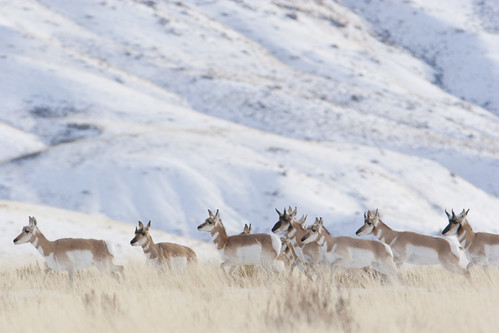
Earlier this month, The Conservation Fund announced the permanent protection of 1,000 acres along the Path of the Pronghorn—the longest land mammal migration route in the continental United States.
A conservation easement will secure the natural resources and habitats on Carney Ranch Company lands within the Pronghorn Funnel Migration Bottleneck at the head of the Upper Green River Valley, helping create a 6,000-acre contiguous block of privately conserved lands.
The Conservation Fund purchased the easement with support from the Farm and Ranch Lands Protection Program (FRPP), a federal program managed by the USDA’s Natural Resources Conservation Service (NRCS) that provides matching funds for the purchase of easements on agricultural land. In this case, NRCS’ funds were matched with funds provided by Jonah Interagency Office, the Wyoming Wildlife and Natural Resource Trust and the National Fish & Wildlife Foundation (through a grant from the Turner Foundation). The landowners also made a significant donation to this project.

Located within some of the most ecologically important lands in the southern part of the Greater Yellowstone Ecosystem, the conserved properties will link significant wildlife habitat between the Bridger-Teton National Forest and other privately protected areas while continuing to be used as working ranchlands. The lands feature a variety of habitats, including 25 glacial-pothole wetland ponds and more than two miles of frontage on the Green River, and provide ideal seasonal habitat for elk, moose, mule deer, greater sage-grouse and trumpeter swan.
“Our family has watched the pressures of civilization impact this valley since 1963,” said John Carney, president of Carney Ranch Company. “The persistent effort of The Conservation Fund has helped our large extended family to realize my parents’ dream to preserve this beautiful place. We are grateful to be able to leave this ranch as part of our legacy for the future.”
Carney Ranch covers a large portion of one of three bottlenecks along the 200-mile migration route stretching from Grand Teton National Park in northwest Wyoming to the Rock Springs area in southwest Wyoming. It is the only bottleneck to occur on private land. Carney Ranch provides habitat for 75 Species of Greatest Conservation Need, according to the Wyoming Game and Fish Department—one of the highest counts ever recorded in the state.
Find out more about FRPP.
Check out more conservation stories on the USDA blog.
Follow NRCS on Twitter.
